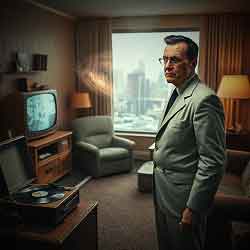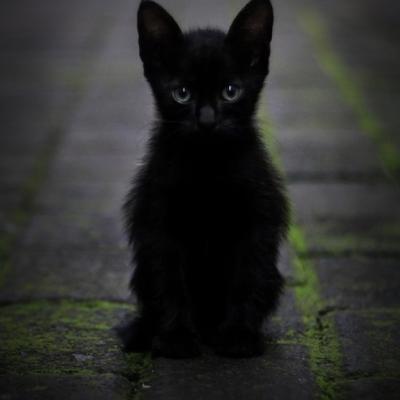 Philip K. Dick understood in 1954 what we refuse to admit in 2025: passivity enables fascism. "Exhibit Piece" is about George Miller, a historian who loves the past so much he retreats into it, choosing a curated fantasy over participating in the real world's struggles. And what do we do in 2025? We watch democracy crumble. We observe rights disappear. We spectate at our own oppression and doom. Miller thinks he's escaped a totalitarian future by fleeing to the free past. He hasn't. He's chosen the comfortable chair and cold beer while reading headlines about total world destruction. And doing nothing.
Philip K. Dick understood in 1954 what we refuse to admit in 2025: passivity enables fascism. "Exhibit Piece" is about George Miller, a historian who loves the past so much he retreats into it, choosing a curated fantasy over participating in the real world's struggles. And what do we do in 2025? We watch democracy crumble. We observe rights disappear. We spectate at our own oppression and doom. Miller thinks he's escaped a totalitarian future by fleeing to the free past. He hasn't. He's chosen the comfortable chair and cold beer while reading headlines about total world destruction. And doing nothing.
The Museum of Your Own Extinction
Philip K. Dick wrote "Exhibit Piece" in 1954 for seventy-five dollars. He was twenty-five years old, broke, living in a mouse-infested Berkeley apartment, and writing pulp fiction at a pace that would kill most men. He had married above his station—Kleo Apostolides was educated, cultured, confident—and he was paying the rent by producing forty stories in three years. This is the context we need. Not to explain the story but to understand what Dick discovered while writing it: that the greatest danger is not participation but spectatorship, that the sin is not living wrongly but watching life happen, and that the museum—that temple of careful, controlled observation—is actually a preparation for death.
George Miller curates an exhibit of the twentieth century. He wears archaic suits with buttons. He carries an alligator-hide briefcase. He speaks with "the accent of an American business man of the Eisenhower administration." He has transformed himself into a living artifact, a breathing museum piece, a man who loves the past so completely he has become its ghost.
But ghosts do not live. They haunt.
Miller's superior Fleming sees this and it enrages him. "You're two hundred years behind times," he snaps. "Immersed in your relics and artifacts. Your damn authentic replicas of discarded trivia." Fleming thinks Miller is lost in the past. He is not. Miller is perfectly, comfortably separate from it—studying it from the safety of two hundred years, several layers of exhibition glass, and the professional distance of the academic who loves his subject the way a taxidermist loves animals. Dead. Pinned. Unable to surprise him.
Then Miller hears sounds from within his exhibit. Someone has crossed the safety barrier. He investigates—and discovers a kitchen. A breakfast table. A wife named Marjorie. Two teenage sons. Hot cakes and coffee. They call him George. They think he belongs there. And Miller, after a moment of beautiful, perfect confusion, sits down.
Dick gives us the transition with devastating understatement: "Miller sank weakly down at the table. Aimlessly, he fooled with his pipe."
Aimlessly.
Note that word. Miller, who curates history with fanatical precision, who knows the exact accent of Eisenhower-era businessmen, who can authenticate every artifact in his exhibit down to the last ashtray—Miller suddenly has no aim. No purpose. No plan. He "fooled with his pipe"—the verb choice is exquisite. Not "held" or "touched" but fooled—the gesture of a man whose hands need something to do while his mind struggles to process the impossible. "He set it down in the copper ashtray and examined the cuff of his coat."
This is how ontological breakdown actually feels. Not thunder and lightning and reality tearing apart with special effects. Just a man at a breakfast table, looking at his coat sleeve, trying to remember how he got there. "What was happening? His head spun."
Three words in the present progressive. Is happening. Right now. And Miller, the historian who knows everything about every moment of the twentieth century, knows nothing about his own present.
Now. We must address Patricia Warrick.
Warrick's Mind in Motion approaches "Exhibit Piece" with all the passion of a coroner performing an autopsy. She reads the story as another example of Dick's "shifting realities" and "ontological breakdown." She catalogs it. Notes its themes. Places it within the larger context of Dick's work. Files it away. She treats the story exactly the way Miller treats history: as a thing to be studied, understood, and kept at professional distance. She has observed the story. She has not read it. The difference, apparently, must be explained to academics.
Miller visits a psychiatrist. One must smile at this detail—psychiatrists are professional observers of life, maintaining careful therapeutic distance while people bleed their souls into fifty-minute hours. Doctor Grunberg listens and offers his diagnosis: "You have a general feeling that everything around you is unreal. A sort of stage."
"An exhibit," Miller corrects him.
But Grunberg, like Warrick, has missed the point entirely. He thinks Miller's problem is believing he's trapped in an artificial world. The actual problem—and Dick is so careful here, so subtle—is that Miller has spent his entire professional life treating the real world as artificial. As something to be observed, studied, kept behind glass. The exhibit hasn't trapped Miller. Miller has finally stopped observing and started living, and the experience is so foreign to him he thinks he's gone insane.
There's a moment—blink and you miss it—where Miller stands between worlds. "There was a faint shimmer in the air, a weak place just at the edge of the parking strip. Through it he could see faint shapes." On one side: the History Agency, safety barriers, controlled exhibitions, the careful preservation of dead things. On the other side: breakfast, wife, sons, a 1954 Buick, life. Miller can see both. He stands at the threshold.
He chooses the exhibit.
Fleming appears, furious. "Miller. Come out of there."
Miller refuses. He stands on the twentieth-century side and makes his case: "I have an attractive wife: marriage is permitted, even sanctioned in this era. I have two fine kids—both boys—who are going up to Russian River this weekend. I have a brand new Buick—"
"Illusions," Fleming spits. "Psychotic delusions."
"Are you sure?"
The question hangs there, unanswered, because Dick knows it's the wrong question. Not "which world is real?" but "what does it mean to actually live in a world rather than curate it?" Fleming's real world—the twenty-second century History Agency—is a totalitarian nightmare. "The Government sets up strict rules for dress." Political officers "supervise the troops. Watch for political deviation." Books are burned. Miller mentions casually that soldiers in this future-made-present tell him "In a total war we have to keep people under constant surveillance" and that "Most of it disappeared. Burned back in '77... Shakespeare. Milton. Dryden. I'll take the old stuff. It's safer. None of the Steinbeck and Dos Passos."
Steinbeck and Dos Passos. The leftist literature. Banned. Burned. Erased.
Fleming offers Miller a real world of surveillance, censorship, and state control. Miller's chosen illusion includes marriage, children, private property, literature. If you must choose between a real totalitarian future and an illusory free past, Miller's choice seems less like madness and more like the only sane response available.
But Dick does not let Miller escape that easily. Dick never lets anyone escape.
Carl Freedman argues that paranoia is Dick's essential mode, that Dick's characters respond rationally to genuinely hostile environments. "Exhibit Piece" confirms this while twisting the knife deeper. Yes, Miller's future is hostile—a surveillance state where thought is monitored and books burn. But Miller's escape is not resistance. It is surrender. The ultimate passivity: refusing to fight the real world in favor of retreating into a carefully curated fantasy of better times.
Miller has not escaped the museum. He has become its permanent resident.
And here—here—is where we must confront what this story actually means, what Dick understood at twenty-five while living in poverty and writing for markets that paid less than minimum wage: that the greatest temptation facing anyone who cares about history, art, or culture is the temptation to become a spectator. To study rather than act. To observe rather than participate. To curate beautiful things while the world burns.
We are spectators now. All of us. Fifty-seven percent, according to the sociologists who count such things. "Passive cultural consumers"—which means we watch life instead of living it. In the UK, twenty-eight percent attend no cultural activities at all. In the US, voter participation hovers around sixty percent in presidential elections, forty percent in midterms. We watch. We post. We comment. We curate our feeds and cultivate our brands and observe catastrophe with professional interest.
And we do nothing.
This is Miller's sin and it is ours. We treat the present as an exhibit to be observed from behind safety glass. We are historians of our own extinction, taking notes on the apocalypse while doing nothing to prevent it. We have become exactly what Miller becomes: comfortable, informed, utterly powerless.
Miller tells Fleming: "I'm in the past, two hundred years back. I've crossed back to a previous existence-coordinate." He believes he has achieved freedom. He thinks he has escaped the totalitarian future for an authentic past. He is wrong on both counts. He has not achieved freedom—he has achieved perfect imprisonment. He has not found the authentic—he has found the perfectly curated simulation of authenticity, which is the most dangerous illusion of all.
Director Carnap threatens to demolish Miller's exhibit "piece by piece" so Miller can "appreciate the scientific and artistic way we take your imaginary world and people apart."
Miller laughs. "You're wasting your time. The exhibit is only a bridge. I'm beyond it now."
He is not beyond anything. He is exactly where he has always been: inside the exhibit, behind the glass, observing life rather than living it. The only difference is that now he cannot see the glass. He thinks he's free. He thinks he's participating. He thinks he's alive.
He sits in his easy chair. Turns on the television. Gets a beer from the refrigerator. Notices the morning newspaper on the coffee table—the newspaper he had been searching for at the story's beginning, the newspaper that started this entire catastrophe. He picks it up. Languidly. Confidently. He unfolds it.
"RUSSIA REVEALS COBALT BOMB / TOTAL WORLD DESTRUCTION AHEAD"
Stop. Let that sit.
Dick wrote this in 1954. The cobalt bomb was real—a theoretical "salted bomb" whose radioactive fallout would render Earth uninhabitable for decades. Physicist Leo Szilard had introduced the concept to the public in 1950. When Dick wrote this story, American children were crawling under desks for atomic drills. The Soviet Union had shocked the US with its 1949 atomic test. The Castle Bravo test in March 1954 had demonstrated that thermonuclear weapons could be orders of magnitude more powerful than predicted. Total world destruction was not science fiction. It was foreign policy.
Miller escaped the totalitarian future by retreating to the past. But the past he chose—the twentieth century of freedom and individuality and bright consumer goods—was the century that built the future he fled. The century that invented totalitarianism. The century that developed atomic weapons. The century that created the conditions for total world destruction.
Miller thought he escaped to a better time. He escaped to the loading dock. To the moment just before the bomb drops. To the last breakfast before the end of the world.
And he sits there, beer in hand, reading the headline, and he does nothing. Because spectators do not act. They observe. They note the significance of events. They understand the implications. And they wait for someone else to change the channel.
Dick understood something about museums that we still refuse to admit: that preservation is a form of death. That careful observation is a form of murder. That the impulse to curate and control and keep things safe behind glass is the same impulse that leads to totalitarianism, to surveillance states, to worlds where books burn and thought is monitored and everyone watches everyone else with professional interest.
Fleming tells Miller: "You damn scholars. Come up out of your tapes and face reality."
But Miller refuses. He chooses the exhibit. He chooses observation over participation. And Dick gives him exactly what he deserves: a comfortable chair, a cold beer, a television, and the newspaper announcing his own extinction.
With nothing to do but read it.
Miller wanted authenticity. Dick gave him a museum. Miller wanted freedom. Dick gave him a cage so perfectly constructed Miller thinks it's the open air. Miller wanted to live in history. Dick trapped him in the moment just before history ends.
This is the final cruelty: Miller gets his wish. He wanted to live in the twentieth century. He got it. Complete with its atomic anxiety, its approaching catastrophe, its comfortable middle-class life built on the edge of total annihilation. He wanted to observe the past up close. Now he's in the front row. Permanent seating. Best view in the house for the end of the world.
And the story ends there. With Miller holding the newspaper. With the headline announcing total destruction. With nothing resolved, nothing explained, nothing learned. Just a man in a chair, reading about his own death, unable to do anything about it because he has spent his entire life—both lives, all lives—learning how to observe rather than act, how to curate rather than create, how to be a perfect, professional, utterly powerless spectator.
The museum is not a refuge. It is a coffin. The exhibit is not life. It is life's perfectly preserved corpse. And the past we idealize—that golden age of freedom and authenticity—was always ground zero. It was always building the bomb. It was always five minutes to midnight.
Miller chose observation. He chose the museum. He chose to spectate at his own apocalypse rather than participate in preventing it.
Dick trapped him there forever.
Comfortable. Informed. Dead.
References:
- Csicsery-Ronay Jr., I. (2000). The science fiction of Philip K. Dick. Science Fiction Studies, 27(1), 1–20.
- Baudrillard, Jean. Simulacra and Simulation. Translated by Sheila Faria Glaser. University of Michigan Press, 1994.
- Dick, Philip K. "Exhibit Piece." If: Worlds of Science Fiction, August 1954.
- Freedman, Carl. "Towards a Theory of Paranoia: The Science Fiction of Philip K. Dick." Science Fiction Studies 11.1 (1984): 15-24.
- Hunter, E.B. "In the Frame: The Performative Spectatorship of Museum Selfies." Text and Performance Quarterly 38.1-2 (2018): 55-74.
- Katz-Gerro, Tally, and Mads Meier Jaeger. "Top of the Pops, Ascend of the Omnivores, Defeat of the Couch Potatoes: Cultural Consumption Profiles in Denmark 1975-2004." European Sociological Review 29.2 (2013): 243-260.
- Link, Eric Carl. Understanding Philip K. Dick. Columbia: University of South Carolina Press, 2010.
- Palmer, Christopher. Philip K. Dick: Exhilaration and Terror of the Postmodern. Liverpool: Liverpool University Press, 2003.
- Reeves, Aaron, and Robert de Vries. "Can Cultural Consumption Increase Future Earnings? Exploring the Economic Returns to Cultural Capital." British Journal of Sociology 70.1 (2019): 214-240.
- Sutin, Lawrence. Divine Invasions: A Life of Philip K. Dick. New York: Harmony Books, 1989. Revised edition 2005.
- Warrick, Patricia S. Mind in Motion: The Fiction of Philip K. Dick. Carbondale: Southern Illinois University Press, 1987.






